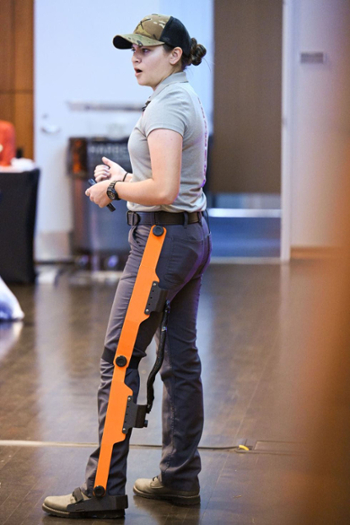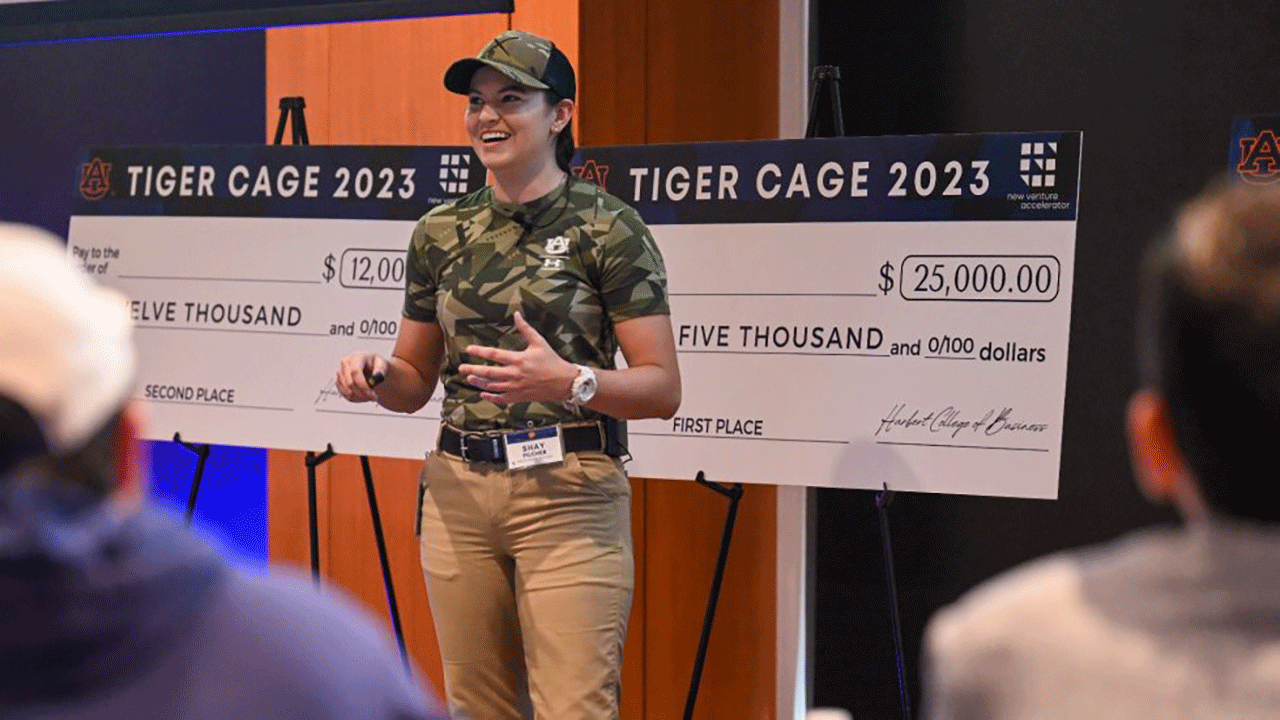Research engineer uses tools she learned at Auburn toward ironclad startup
Published: Jun 28, 2023 9:00 AM
By Staff Report
It is hard to trace exactly when Shay Pilcher, founder of Archangel Defense and a research engineer in mechanical engineering, began her entrepreneurial journey, but suffice to say, it was very early in her life. One incident that occurred just a few years ago solidified that mission.
“I was standing in the checkout line at Walmart one night and I’m pretty sure it was in the spring of 2020,” said Pilcher, who earned her bachelor’s and master’s degrees in mechanical engineering from Auburn. “I had a rough semester and was carrying a big bag of chips in one hand and a tub of ice cream in the other to try and soothe my soul. Right in front of me was a mom and her little boy, who was holding up a huge box of Legos saying ‘Please, please, please can we buy this? Please!’ And the mom was saying, ‘No, I’m not buying that.
“I grew up on Legos, building things with my dad, and it struck a chord in me. It just so happened that the little boy was holding the Marvel Ironman set, and Ironman was my favorite action hero growing up. I said to the mom “I don’t want to be rude, but would you mind if I bought it for him? I grew up playing with Legos, loved Ironman and I’m an engineering student at Auburn. It would just thrill me if I could get it for him.”
“After a little back and forth, she let me buy it for him and, of course, he’s excited. As we were walking out of the store, she turned back to me as her boy walked ahead and said, ‘I want to thank you again and feel I need to tell you why he likes Ironman so much.’ She explained to me that when her son was a baby, his father was killed serving overseas. ‘When he finally became old enough for me to tell him what happened to his father,’ she said, ‘he told me that maybe if daddy had had an Ironman suit, he could have fought off the bad guys.’”
“I went home and cried my eyes out over and over,” confessed Pilcher. “Here I was feeling so down about getting a bad grade in a class. That’s when I realized there are more important issues to focus on, bigger things I could be doing.”
Ironman Suits
Pilcher’s entrepreneurial journey began well before her Walmart Legos epiphany, and Ironman played a role in it as far back as she can remember. Her company’s mission is to design and produce customized “exosuits” that replicate and power critical human movements to provide wearers with additional muscle strength and endurance – particularly while running or carrying heavy equipment. Initial applications appeal to U.S. special forces military combatants who often need extended range of movement while packing heavy gear or traveling long distances at rapid speeds. Other markets include medical devices, robotic prosthetics, physical therapy and athletics.

“The term ‘exoskeleton’ has been used to describe some of what we’re doing, but that connotes a very limiting physical structure such as those used to assist workers lifting boxes in a warehouse, for example. What we’re talking about is much closer to Ironman capabilities than these relatively rudimentary robotic assist systems.”
Pilcher said she is focused on special forces combatants because of the unique challenges they face and the lack of viable solutions to their most critical needs.
“From what the military experts I’ve spoken with tell me, when you’re being shot at, the key thing is to be able to move and keep moving – all while carrying 40 or 50 pounds of gear. You have to go and keep going, and you’re going to get tired. Our mission is to keep soldiers – and firefighters, paramedics and other first responders, for that matter – from getting tired. We want them to be able to keep moving. Endurance is our first goal. We want to make sure that if they need to move for miles at a time without slowing down, we’re going to empower them to do just that.”
The exosuit Archangel Defense is developing will do the bulk of the work for the wearer, helping them maintain a steady, high rate of speed – while leaving their arms and hands free to hold and fire their weapons at will. Lift-assist systems developed primarily for commercial applications don’t even attempt to do that. The structural, bio-mechanical and electronic considerations these basic units are designed around simply won’t work for the much more sophisticated, free-motion systems required for active combat scenarios.
“Wearers will have the full range of body motion,” Pilcher said. “This is not going to inhibit their normal range of movement – nor obstruct their field of vision. These are key design mandates. Another feature of our system is that it doesn’t engage until needed – it knows when assistance is called for and how much to provide – constantly monitoring the wearer’s own muscle, cardio and pulmonary activity to keep need and output in sync.
Laser-focused Bio-Mechanical Design
Unlike Ironman’s suit, which covers his entire body and acts as both protector and enabler, Archangel’s system is purely functional – it does not serve as armor. It is designed to provide the specific type and level of muscular assistance needed where it is needed most – core, legs, arms, back. Specific muscle groups are studied in terms of their contribution to running, balance, upper body flexibility, etc., generating the real-world data required to move a single individual quickly and for a long time. Each system is custom fitted to each person based on their unique size, shape, strength, endurance, etc.
“We begin by taking a full 3D scan of your body structure and import that into a software program we use to build the system. That program is sent to a 3D printer which can produce it within a day. We’re developing a proprietary polymer that’s actually a composite vs. a metal- or plastics-based substrate. This enables us to make the structure lighter by ‘skeletonizing’ it – putting grooves and holes in places where there’s no structural impact.”
Weight is a critical consideration across the entire design, says Pilcher. The heavier it is, the more power it takes to operate, which means the actuators that generate motion at every juncture need to be bigger, the batteries have to be larger, adding more weight. “It can become a vicious circle,” Pilcher said, “a tail you’re never going to stop chasing. On the other hand, every ounce we can drive out to the design means a corresponding reduction in power required for essential components, so it works both ways.”
It’s electronics, however, that drive the system – a combination of hardware and software that both tracks the body’s output and then delivers the performance called for. Motors – steppers, servos – can be scaled and programmed for specific outputs, recognizing that there is only so much a human body can take. The system can be programmed to set thresholds for outputs – how fast, how far or how long it should strive to achieve – so that joints, tendons, ligaments and muscles aren’t taxed beyond their capability.
“We begin with an initial, personalized assessment, and then calibrate each system individually with electromyography (EMG) sensors that measure the small electrical signals generated by your muscles when you move, picking up these signals through the skin. We can tune these motors to those electrical signals so they understand just how much you’re giving and how much more they need to help. It isn’t enough to use size, shape and weight data alone – people with the same basic measurements can vary widely as to how much they can lift, how fast they can run, or how far. For example, I could probably lift more than somebody else my exact same size, run faster and further, perhaps.”
The system learns and adjusts its output over time as well. I will know how much assistance is needed at the start and how much to increase that help as the individual tires. It will constantly pick up what the body is outputting and adjust to the threshold set for that individual. It also knows that a 50% assist level at the beginning of a run is different from what is required for a 50% assist at the end of a run.
“The actuators are the crucial elements here. Our goal is to create flexible actuators that literally function just like you took the muscle outside of the body and popped it back on top of the skin. That provides freer, much more natural motions than possible with big, bulky pneumatic cylinders hanging off your waist, arms and legs. They can get tangled up in brush or caught on doorways.”
Pilcher points to the fact that our muscles don’t simply hang off the side of us and our limbs, they are integrated within and around our skeleton, powering our movements from within. “Our actuators will get as close as possible to replicating the positioning and placement of our own muscles without penetrating the skin. That’s where the bulk of our research and development is focused today. Actuators and battery technology are front and center right now.”
The Auburn NVA Factor
Pilcher says Auburn University and the New Venture Accelerator play an increasingly important role in her success to date and prospects going forward. She cites building stronger relationships with the military and partnership with world leaders in additive manufacturing – 3D printing – as being particularly important objectives at this stage of the company’s development.
“At Auburn, we have a wealth of engineering, biomechanics and kinesiology expertise available to draw upon,” said Pilcher. “It really is quite extraordinary. From the research I am involved with at the College of Engineering to the relationships our faculty has established in the additive design and manufacturing space, I couldn’t be better positioned for success here at Auburn.”
Pilcher also notes that the New Venture Accelerator has been instrumental in helping her and her team find the experience and support they need from across the university and beyond. “With a mission that encompasses so many technologies in unprecedented ways, figuring out where to find that expertise is critical. We wouldn’t be as far along as we are today without the counsel and hands-on support available at the NVA.”
Media Contact: , rws0022@auburn.edu, 334.844.7947
Shay Pilcher earned undergraduate and graduate degrees in mechanical engineering.

